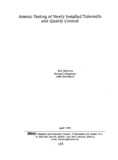Arsenic testing of newly installed tubewells and quality control
Citation
Jakariya, M., Johnstony, R., & Chowdhury, A. (1999, April). Arsenic testing of newly installed tubewells and quality control. Research Reports (1999): Health Studies, Vol - XXVIII, 395–409.Abstract
The presence of arsenic in groundwater in Bangladesh has aroused widespread concern.
It is estimated that over half of the Bangladesh population are at risk of arsenic poising.
The source of arsenic in drinking water is from the tubewells. There are over four million
tubewells in Bangladesh. During 1997-1998, DPHE installed over 13,000 tubewells in a
UNICEF supported Safe Water Supply Project .. At the request of UNICEF, BRAC test all
the above mentioned tubewells for Arsenic contamination. In doing this, BRAC need a
field kit and the quality of the testing was also assessed by simultaneous testing in a
laboratory.
The proportion of tubewells with an arsenic content above the acceptable limit (=1< 50
ppb) was found to be 4.27% of 12,604 tubewells tested. Tubewells above the accepted
limit were painted red , whereas those within the accepted limit were painted green by
the field testers. The quality of testing by the field testers was found to be high ana the
effectiveness of the field kits was found to be adequate. DPHE have been relatively
successful to avoid arsenic affected areas as the number of tubewells contaminated with
arsenic above the acceptable limit was low.
The sub assistant engineers also mentioned that one of the main reasons for not installing
all the allocated tubewells particularly in the arsenic affected areas was due to arsenic
contamination in ground water.
Caretakers of each tubewell were given information on what to do if the tubewell tested
arsenic contaminated. They were also given a leaflet provided by UNICEF containing
information on arsenic and altenative safe water options.

